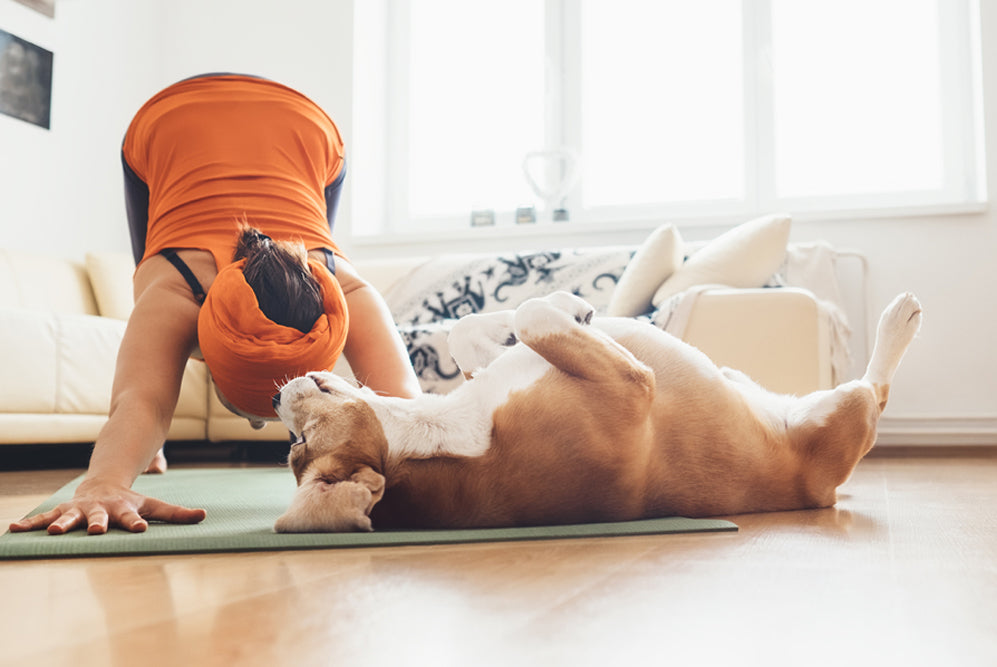Puppy yoga has gained popularity as a unique and enjoyable way to combine exercise with the joy of playing with adorable furry companions. The concept involves practicing yoga while surrounded by playful and affectionate puppies. But have you ever wondered where these puppies come from?
We'll explore the origin of puppy yoga's delightful participants and shed light on the heartwarming process that brings them to these classes. By understanding the source of these puppy yogis, we can appreciate the positive impact that this practice has on both the puppies and the people who participate in these sessions. So, let's delve into the journey of these adorable pups and discover the story behind their involvement in the world of yoga.
The Puppy Yoga Trend
Puppies used in the popular puppy yoga trend are typically sourced from animal shelters and rescue organizations, providing a unique opportunity for the pups to socialize and find new homes.
The Concept Of Puppy Yoga
Puppy yoga has become a trend that brings together the benefits of yoga with the irresistibly adorable presence of puppies. This unique practice combines the calming effects of yoga with the joy and playfulness of puppies, creating a truly blissful experience. The concept behind puppy yoga is to create a safe and tranquil environment where participants can achieve physical and mental relaxation while interacting with the puppies. The puppies roam freely around the yoga studio, providing endless opportunities for cuddling, petting, and even incorporating them into certain yoga poses.
The Rising Popularity
Puppy yoga has gained tremendous popularity in recent years, with yoga enthusiasts and dog lovers alike flocking to classes and events worldwide. The allure of this trend stems from the undeniable positive impact that puppies can have on our overall well-being. The therapeutic nature of interacting with puppies during a yoga session enhances the benefits of the practice itself. The presence of these furry friends helps to release stress, boost mood, and promote a sense of happiness and contentment. Furthermore, puppy yoga serves as a bridge between fitness and relaxation. While the yoga stretches and poses work wonders for the mind and body, the presence of puppies adds an extra layer of fun and enjoyment, making the overall experience more engaging and exciting. As a result, the demand for puppy yoga classes continues to rise, with yoga studios, animal shelters, and charitable organizations collaborating to offer these unique sessions. Not only does puppy yoga provide a wonderful opportunity for people to experience the joy of practicing yoga, but it also brings attention to important causes, such as animal adoption and animal welfare. Overall, puppy yoga has captured the hearts of many, offering a delightful and rejuvenating way to incorporate cuddles and cuteness into a yoga routine. So why not give it a try and experience the magic of puppy yoga for yourself?
The Source Of The Puppies
Puppies participating in puppy yoga come from local animal shelters and rescue organizations. These adorable pups are up for adoption, and engaging in yoga classes provides a wonderful opportunity for socialization and exposure to potential adopters.
Puppy yoga has become a popular activity for dog and yoga enthusiasts alike. While getting to participate in a yoga class with adorable puppies can be a joyful experience, you might wonder where these puppies come from. In this blog post, we will explore the different sources of puppies for puppy yoga, including shelter dogs and breeders and rescues.
Shelter Dogs
Shelter dogs play an important role in providing puppies for puppy yoga classes. These are dogs that have been abandoned, lost, or surrendered by their previous owners and are awaiting adoption. When you attend a puppy yoga session, you may be interacting with puppies that come from local animal shelters. By participating in puppy yoga, you not only get to enjoy their company but also contribute to the exposure and socialization that can help these puppies find their forever homes.
Breeders And Rescues
Breeders and rescues are another source of puppies for puppy yoga. Breeders are individuals or businesses that specialize in breeding specific dog breeds. They carefully select the parent dogs with desirable traits to produce healthy and well-rounded puppies. Rescues, on the other hand, are organizations dedicated to rescuing and rehoming dogs in need. They often have a variety of dog breeds and mixed-breeds available for adoption, including puppies. It's important to note that responsible breeders and rescues prioritize the health and well-being of their puppies. They raise them in clean and safe environments, provide them with proper veterinary care, and ensure they are well-socialized before being introduced to activities like puppy yoga. In conclusion, the puppies you meet during a puppy yoga session can come from various sources. They can be shelter dogs waiting for their forever homes or puppies from reputable breeders and rescues. Regardless of their origin, these puppies bring joy and happiness to the puppy yoga experience while also raising awareness about pet adoption and responsible pet ownership. So why not combine the benefits of yoga with the adorable companionship of puppies and experience the joy that puppy yoga has to offer?
Ethical Considerations
When it comes to puppy yoga, there are some important ethical considerations to take into account. It's essential to assess the origins and welfare of the puppies involved, as well as the impact on puppy adoption rates.
Animal Welfare Standards
Animal welfare is of utmost importance when it comes to puppy yoga. Puppies involved in these sessions should come from reputable breeders or rescue organizations that prioritize the well-being of their animals. Proper care, socialization, and healthy living conditions are crucial for the overall well-being of the puppies. It's important for yoga organizers to vet the sources of the puppies and ensure that they meet established animal welfare standards.
Impact On Puppy Adoption
The popularity of puppy yoga can have both positive and negative effects on puppy adoption. Exposure from these events can lead to increased interest in adopting a puppy. However, there's a risk of impulsive adoptions, leading to abandoned pets if individuals aren't fully committed to caring for a pet long-term. Organizers should encourage responsible adoption and provide information on the commitment required to care for a puppy.

Credit: www.ebay.com
Regulations And Guidelines
Puppies used in puppy yoga classes come from reputable breeders who adhere to strict regulations and guidelines. Ethical sourcing ensures the well-being and health of the puppies, promoting a positive yoga experience for participants.
Legal Framework
Local laws ensure ethical sourcing of puppies for yoga classes.
Organizational Standards
Established guidelines dictate handling and treatment of puppies in yoga sessions.
Benefits Of Puppy Yoga
Puppy Yoga, an innovative wellness practice, combines the benefits of yoga with the playfulness of puppies. Let's explore the advantages of incorporating puppies in yoga sessions.
Physical And Mental Health
Engaging in puppy yoga enhances physical flexibility and strength through yoga poses that require movement and balance.
The presence of puppies promotes relaxation and reduces stress levels, leading to a more centered mind during yoga practice.
Social Impact
Puppy yoga fosters a sense of community and camaraderie among participants and encourages social interactions through shared experiences.
The bond formed between humans and puppies in these sessions can increase feelings of joy and fulfillment.

Credit: www.amazon.com
Educating Participants
Puppy yoga is an enjoyable and relaxing activity that combines yoga with the presence of adorable puppies. However, it's crucial to educate participants about the origins of the puppies involved.
Promoting Rescue Adoption
When participating in puppy yoga, promoting rescue adoption is emphasized. All the puppies involved in the sessions are from animal shelters or rescue organizations. This not only provides these puppies with exposure and the opportunity to find forever homes but also raises awareness about the importance of rescue adoption.
Responsible Pet Ownership
Responsible pet ownership is a core focus during puppy yoga sessions. Participants are encouraged to understand the long-term commitment of owning a pet and the responsibilities involved. This includes proper care, training, and providing a loving and safe environment for their furry friends.
Future Implications
Discovering the origin of puppies in puppy yoga poses questions about ethical breeding practices and animal welfare standards. Understanding the implications can lead to informed decisions before participating.
Sustainability Of The Trend
Evolution Of Puppy Yoga
Puppy yoga has undoubtedly become a popular trend among yoga enthusiasts and dog lovers alike. This unique combination of exercise and furry companionship has taken the wellness world by storm. However, as with any trend that gains widespread attention, it is essential to consider its future implications. Let's delve into two crucial aspects: the sustainability of the trend and the evolution of puppy yoga over time.
Sustainability Of The Trend
When it comes to sustainability, one must inquire about the source of the puppies used in puppy yoga sessions. Ensuring that the well-being of the animals involved is prioritized is of utmost importance. Puppy mills and unethical breeders are a concerning issue in the pet industry. Unfortunately, such establishments prioritize profit over the welfare of animals. To sustain the puppy yoga trend ethically, promoting adoption from reputable shelters and rescue organizations should be emphasized. By partnering with local animal shelters, yoga studios can provide a platform for rescued puppies to find their forever homes while bringing joy to yoga practitioners.
Evolution Of Puppy Yoga
The evolution of puppy yoga presents exciting possibilities for the future. As this trend continues to grow, innovative concepts are emerging to cater to different preferences and needs. Some yoga studios now offer specialized puppy yoga sessions for children, creating a joyful and engaging experience for young practitioners. Others have extended the concept to include elderly populations, recognizing the therapeutic benefits of these furry companions. Moreover, technology has the potential to revolutionize the way we experience puppy yoga. Virtual reality and augmented reality could transport individuals to tranquil environments, allowing them to practice yoga with virtual puppies. These advancements could make puppy yoga more accessible to a wider audience and further increase its popularity. In conclusion, while puppy yoga has gained immense popularity, it is crucial to consider its future implications. By focusing on the sustainability of the trend and encouraging ethical practices, puppy yoga can continue to bring happiness and wellness to both humans and animals. Additionally, the evolution of puppy yoga opens up exciting possibilities for different age groups and the integration of technology. Let's embrace the future of puppy yoga while remaining mindful of the well-being of these adorable furry companions.

Credit: www.udemy.com
Frequently Asked Questions For Where Do Puppies From Puppy Yoga Come From
Where Can I Adopt Puppies Like The Ones In Puppy Yoga Classes?
Adoption centers, shelters, and rescue organizations provide puppies for Yoga classes, promoting pet adoption and animal welfare. Research local organizations or adopt from a shelter to find a furry companion for your Yoga session.
What Are The Benefits Of Practicing Yoga With Puppies?
Practicing Yoga with puppies can reduce stress, increase happiness, and improve overall well-being. Interacting with cute, playful puppies during Yoga classes enhances relaxation, promotes mindfulness, and boosts mental health, creating a unique and joyful experience.
How Do Puppies Enhance The Yoga Experience?
Puppies provide companionship, encourage movement, and add an element of fun to Yoga classes. Their presence fosters a sense of connection, increases motivation, and brings positive energy to the practice, making Yoga sessions more enjoyable and memorable.
Conclusion
Puppy yoga is an adorable trend, but it's crucial to know the source of these furry participants. By supporting ethical breeders and rescue organizations, you can ensure these puppies are treated responsibly. Remember, the well-being of the puppies should always come first in any puppy yoga session.









:strip_icc()/Steps-to-train-your-dog-1118273-7f3a74792b15472bb0d1f4884bd95875.jpg)
:strip_icc()/fun-and-easy-dog-tricks-1117309_final-5c8d880763aa42fb879ae09dd3514253-00abace26875464785f054d8fec111c5.png)











